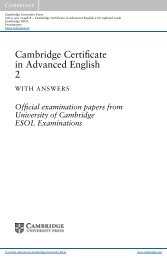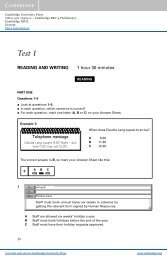Chapter 1 - Assets - Cambridge University Press
Chapter 1 - Assets - Cambridge University Press
Chapter 1 - Assets - Cambridge University Press
You also want an ePaper? Increase the reach of your titles
YUMPU automatically turns print PDFs into web optimized ePapers that Google loves.
<strong>Cambridge</strong> <strong>University</strong> <strong>Press</strong>978-0-521-73830-9 - Physics 2 for OCRGurinder Chadha and David SangExcerptMore information<strong>Chapter</strong> 1: MomentumYou should be able to see that, in this collision,both momentum and kinetic energy are conserved.Before the collision, we have an object A of massm moving to the right at speed v and an object B ofmass m moving to the left at speed v. Afterwards, wehave the same, but now object A is moving to the left,and object B is moving to the right.Mathematically, we can express this as follows:Before the collisionObject Amass = mvelocity = vmomentum = mvObject Bmass = mvmvSo the total momentum and the total kinetic energyare unchanged. They are both conserved in a perfectlyelastic collision such as this.An inelastic collisionIn Figure 1.9, the same two objects collide, but thistime they stick together after the collision and cometo a halt. Clearly, the total momentum and the totalkinetic energy are both zero after the collision, sinceneither mass is moving. We have:Before collision After collisionmomentum 0 0kinetic energy mv 2 0The object B has negative velocity and momentumbecause it is travelling in the opposite direction toobject A.Therefore we have:total momentum before collision= momentum of A + momentum of B= mv + (–mv) = 0total kinetic energy before collision= KE of A + KE of B= 1 2 mv2 + 1 2 mv2 = mv 2The magnitude of the momentum of each object is thesame. Momentum is a vector quantity and we haveto consider the directions in which the objects travel.The combined momentum is zero. On the otherhand, kinetic energy is a scalar quantity and directionof travel is irrelevant. Both objects have the samekinetic energy and therefore the combined kineticenergy is twice the kinetic energy of a single object.After the collisionBoth objects have their velocities reversed, andwe have:Atotal momentum after collision= (–mv) + mv = 0total kinetic energy after collision= 1 2 mv2 + 1 2 mv2 = mv 2mvbeforevmpositivedirectionafterB A Bm mFigure 1.9 An inelastic collision between twoidentical objects.Again we see that momentum is conserved here.However, kinetic energy is not conserved. It is lostbecause work is done in deforming the two objects.In fact, momentum is always conserved inall collisions. There is nothing else into whichmomentum can be converted. Kinetic energy isusually not conserved in a collision, because it canbe transformed into other forms of energy – soundenergy if the collision is noisy, and the energyinvolved in deforming the objects (which usuallyends up as heat – they get warmer). Of course, thetotal amount of energy remains constant as prescribedby the principle of conservation of energy.6© <strong>Cambridge</strong> <strong>University</strong> <strong>Press</strong> www.cambridge.org
















